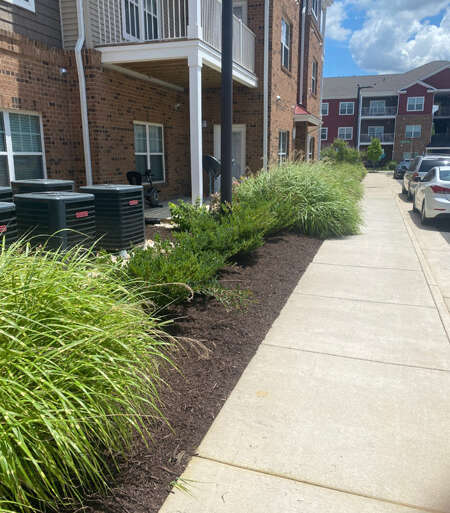 Have you asked yourself the following questions about irrigating your Richmond lawn and landscape:
Have you asked yourself the following questions about irrigating your Richmond lawn and landscape:
- “When is the best time to water my lawn?”
- “What temperature is too hot to water grass?”
- “Can I water at night?”
- “Why do my landscape plants look wilted the day after I water them?”
You may have heard some watering myths, such as
- “Watering your lawn at night won’t hurt it.”
- “A garden hose is good enough for watering your lawn.”
- “You can plant your annuals and perennials anywhere you want.”
- “A daily sprinkle will keep your yard and beds looking their best.”
In this blog, you’ll learn the truth about what your Central VA lawn and landscape need when it comes to watering for healthy plants.
10 Watering Myths You Need to Avoid
Over- and underwatering are both harmful to your lawn and gardens. Underwatering stresses your grass because the turf develops shallow roots that can’t reach deep underground for moisture.
Conversely, overwatering your lawn and landscape leads to washing away nutrients and soil. It also causes plant diseases.
Read more: What You Need to Know About Caring for Your Central VA Lawn This Summer
Here are 10 watering myths you need to avoid:
- Watering at night – When you water at night, the moisture sits on the plants, where fungal diseases develop on both your turf and perennial beds.
When is the best time to water your lawn?
Watering your lawn between 4 a.m. and 6 a.m. when it’s cool is the best time. You may want to invest in a timer for your sprinkler hoses or an in-ground lawn sprinkler system with a clock that you set to go off in the early morning hours.
- Giving your yard and flowerbeds a daily sprinkle – Running your garden hose over your lawn for a few minutes and then lightly watering your landscape doesn’t provide the plants with the deep watering they need.
- Planting turfgrass and other plants in any part of your property – All plants have different light and watering needs. If you install a lawn or a flowerbed willy-nilly, you’ll notice that your plants aren’t thriving.
- Not investing in an in-ground sprinkler system or soaker hoses – While an in-ground sprinkler system might not be in everyone’s budget, you can invest in sprinkler hoses and dripline irrigation to deliver water directly to the plants’ root systems where it’s needed.
- Watering from the top of the plant downward – You might think that all parts of a plant, such as phlox or salvia, benefit from getting wet
![]() However, you’re only opening up your plants to fungal diseases and drought stress. You need to concentrate the watering at the root level avoiding the leaves and flower parts.
However, you’re only opening up your plants to fungal diseases and drought stress. You need to concentrate the watering at the root level avoiding the leaves and flower parts.
- Scalping your lawn when you cut the grass – Your turfgrass won’t grow deep root systems to find moisture or survive drought stress if you scalp your yard.
Plus, cutting your grass too low to the ground means that you’re mowing it too often—causing it more stress and opening it up for insects and disease.
- Allowing weeds to take over your lawn and garden – Your plants compete with weeds for water and sunlight. Hand weeding and using weed control limit the number of weeds competing for H2
Learn more: Why You Need to Add Landscape Enhancements to Your Central VA Property
- Using no mulch in your landscape – If you want your annuals, perennials, shrubs, and trees to survive the relentless heat of the summer, you need to install mulch.
Mulch keeps moisture in the soil and reduces weeds. Plus, mulch keeps the soil temperature even so it doesn’t stress your landscape plants.
- Providing no lawn or plant health care throughout the growing season – Your plants need regular care starting in the fall and going throughout the spring and summer to keep your turf and beds looking their best.
Also, plant and lawn care keeps moisture in the soil, allowing plants to develop deep roots to find moisture in the ground, and helps plants survive heat stress.
- Planting different types of plants in the same area – While you may want to stick to a color wheel when you’re designing your flowerbeds, know that all plants have different watering needs.
Instead, it’s better to group your plants according to their watering needs—this is called hydrozoning. For example, sedums and ice plants don’t need as much water as other plants.
So, plant the sedum and ice plants in a bed with other plants that don’t need as much water as bee balm and garden phlox.
How BCLS Landscape Services Partners with You
When you hire a professional landscaping company to work on your property, you’re entering a partnership. At BCLS Landscape Services, we’ll provide the best lawn and plant health care, so you have the building blocks for a beautiful property.
We also provide irrigation installation and maintenance services. If you choose to invest in an in-ground sprinkler system, we’ll help you find the right one for your needs. Our sprinklers come with technology designed to save water and put more money in your pocket.
Call us today at (804) 752-0052 or fill out our contact form. We look forward to working with you to care for all your lawn care and landscape maintenance needs.
BCLS Landscape Services provides property care to residential and commercial properties throughout Richmond and Central Virginia.


